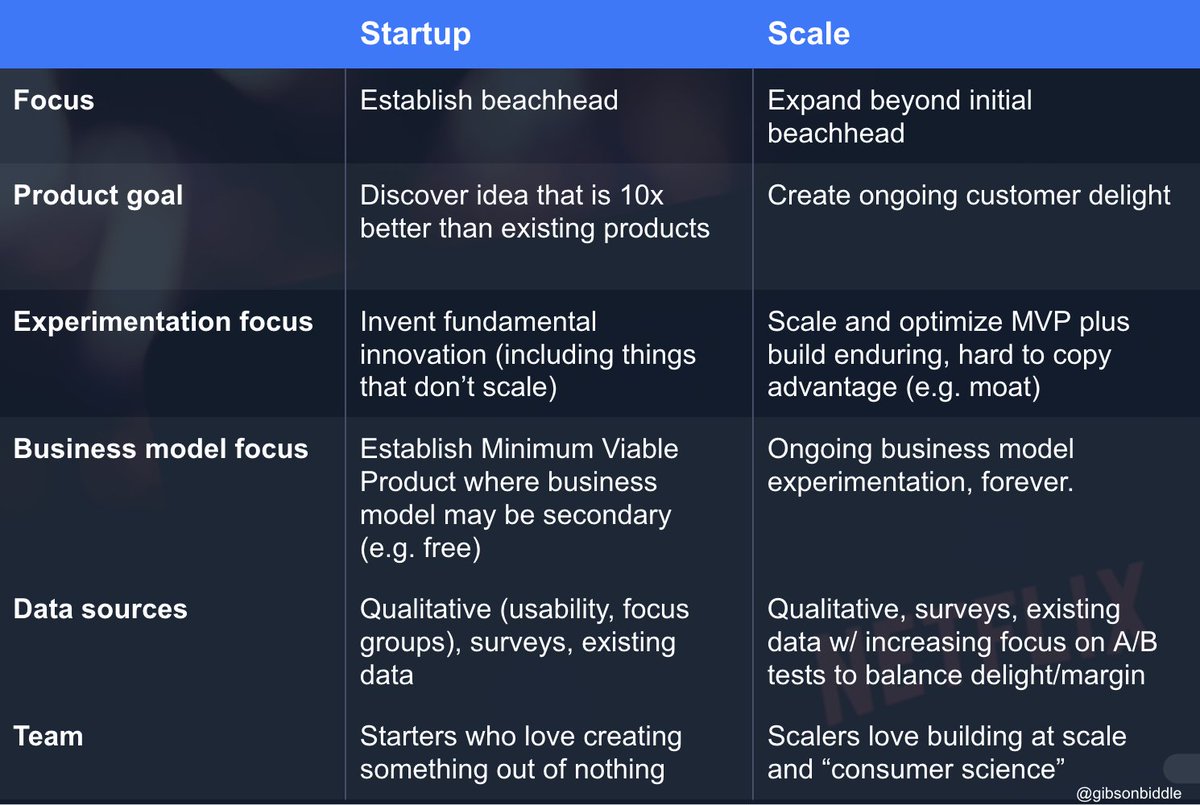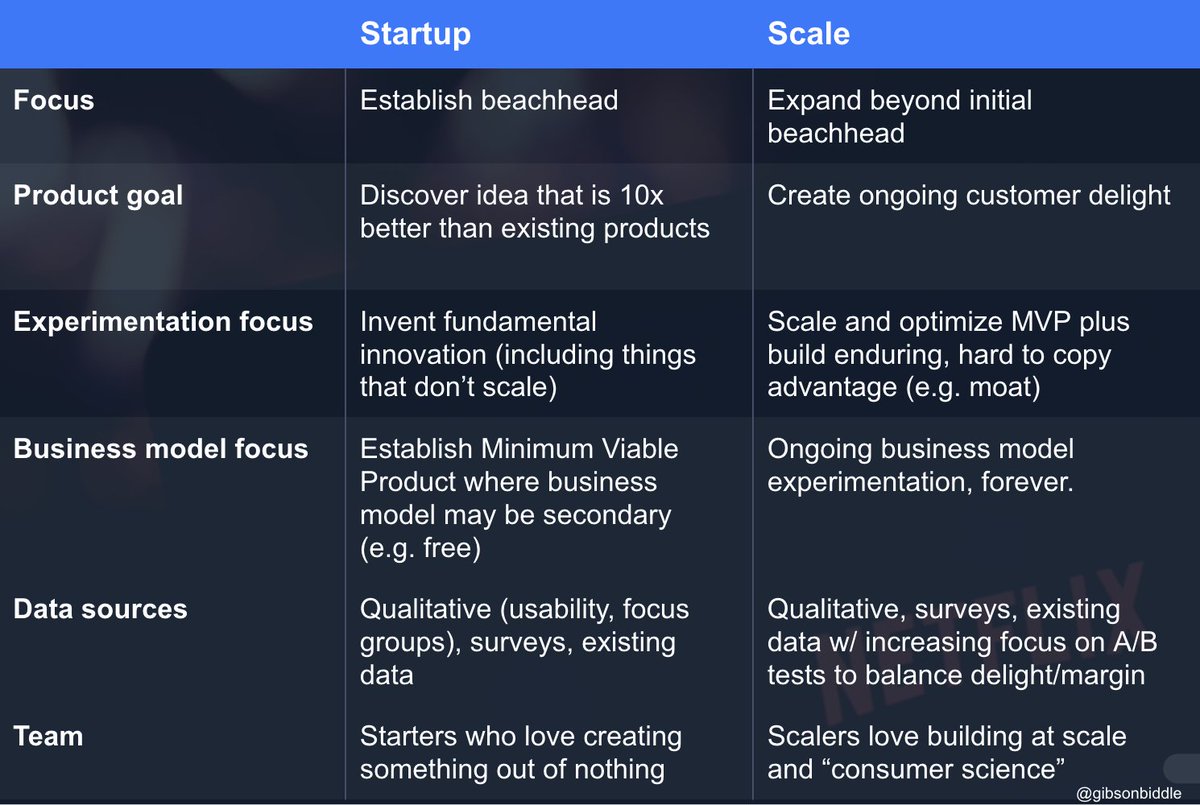1) I've been thinking about product strategy in the context of very early startups & more established, scaling startups. In product strategy, I focus a lot on "delighting customers in hard to copy, margin-enhancing ways." But in the beginning, it's all about delight.
2) The differences first hit me at Electronic Arts in 1991. An MBA pal did a Michael Porter strategy analysis on a whiteboard for a startup we hoped to spin out. A VP took one look, erased his work, then wrote "OPPORTUNISTIC" across the board.
3) At startups, the job is to establish an initial beachhead to connect with a small subset of customers. In scaling, you shift gears to expand. That's when you engage in the discipline of building hard to copy advantage and business model experimentation via product strategy.
4) With early startups, you land on the beach and cast about for ideas that are 10x better than anything else. At Chegg, the earliest exploration was "Craigslist for College." (Bad idea!) Eventually, Chegg landed on textbook rental. Students save tons of money renting v. buying.
5) I borrowed "10X better" from "Zero to One" ( https://amzn.to/2EaZxZA ). The point: You need to focus on delight. @paulg's essay "Do Things That Don't Scale" ( https://bit.ly/3g6EGUq ) outlines why you shouldn't worry about scalability and reinforces the Importance of delight.
6) Once you establish your beachhead, the pursuit of delight never ends. But you do add building hard to copy advantage -- network effects, economies of scale, unique technology, brand-- to the mix. And business model experimentation becomes much more important.
7) In the startup phase, the extent to which you focus on the business model varies. Many startups build out a free model then add paid tiers later. Some enterprise startups find it helpful to engage one paying customer as a reference customer. There's no right answer.
8) But as a startup establishes itself and scales, the focus on delight and building hard to copy advantage needs to be persistent. A mistake that many scaling startups make is to stop experimenting with the business model.
9) Netflix began as an a la carte DVD by mail company. In 2000, they bet the company on today's "all you can eat" subscription model. They experimented with advertising/previously viewed disk sales in 2005, and have tested their price and plan configurations, forever.
10) Today, a substantial source of Netflix's advantage is their ability to "right-size" content investment, based on their forecast of how many views each title will get. Netflix can create reasonably accurate forecasts because they know the movie tastes of 185M members WW.
11) I'd spitball that "Stranger Things" gets an investment of $500M because Netflix forecasted that 100M members would watch it. "Bojack Horseman" gets a $100M investment because they forecasted 20M members would watch it.
12) Netflix's personalization strategy is a great example of how to delight customers in hard to copy, margin-enhancing ways. Personalization makes it easy to find & watch movies you'll love, it's hard to copy NFLX's algorithms, and "right-sizing" improves margin.
13) As companies go from very early startup to scale, the data sources required to develop consumer insight change. Most startups complain they don't have the huge data/AB test systems of Netflix. But they do have many sources of data available to them.
14) No matter the stage, there are four sources of data to develop consumer insight:
1) Qualitative (focus groups, interviews, usability)
2) Surveys
3) Existing data (about your customers/their behaviors)
4) AB test results
1) Qualitative (focus groups, interviews, usability)
2) Surveys
3) Existing data (about your customers/their behaviors)
4) AB test results
15) Yes, startups don't have the data scale/integrity of Netflix but there are tons of tools that make it easier -- SurveyMonkey, Amplitude, Optimizely, Pendo-- so there's really no excuse NOT to explore all four sources of consumer insight.
The difference: robust AB test systems are required to discover the balance of delight & margin. You need large AB tests to figure this out. Example: You want to watch all of HBO's content on Netflix, but are you willing to pay the large price required? (Answer: No.)
16) The other difference I notice between early startups and scaling startups is they often require different types of employees. The early "starters" love open field running and building something out of nothing. The "scalers" love the discipline of optimization.
17) I often need to convince startups to rebuild teams as they scale. When I joined Netflix, the PM team were "starters" who weren't 100% on board with the discipline of "consumer science" and AB testing. I spent a year rebuilding it.
18) I learned years ago that I am more of a builder/scaler than a "starter." I require more data to make decisions and get frustrated by the lack of resources in a just-formed startup. And I LOVE having more resources to build stuff as the product/team/company scales.

 Read on Twitter
Read on Twitter



